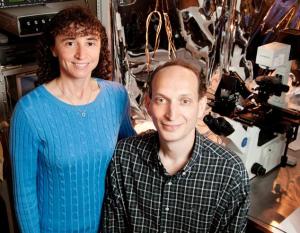摘要:利用观测单分子的高分辨率显微技术,伊利诺伊大学研究人员发现门控离子通道两个分支家族的细微差别,该通道是由神经递质介导的。烟碱型受体是一种嵌入神经元和肌肉细胞的膜蛋白,而神经递质如乙酰胆碱,可触发受体蛋白构象改变,致使大量离子流入细胞内,这一个过程是由通道蛋白调控的。此类受体是肌肉运动和神经系统疾病的元凶。相关研究发表在 Nature杂志上。

两种门控离子通道构象的发现者
Using a high-resolution single-molecule study technique, University of Illinois researchers have seen the very subtle differences between two branches of an important family of neurotransmitter-gated ion channels.
Professor Claudio Grosman and research scientist Gisela Cymes published their work in the journal Nature.
Nicotinic-type receptors are proteins embedded in the membranes of nerve and muscle cells that regulate activity. A neurotransmitter, such as acetylcholine, triggers a small conformation change in the protein that opens a channel and allows ions to flow into the cell. These receptors are key players in muscle motion and neurological diseases such as epilepsy.
The protein family is divided into two classes, with very similar structure but different function: One mediates inhibition by channeling anions, or negatively charged ions, while the other mediates excitation by channeling positively charged cations.
"This is the yin and yang of the central nervous system," said Grosman, a professor of molecular and integrative physiology, of biophysics and of neuroscience. "The anion members of the family and the cation members of the family pretty much look the same. The overall structure is the same. So, the question is, what is the reason for the different charge selectivity?"
The team focused on the segment of protein lining the inside of the channel. The two types of channels display very small differences in their sequence of amino acids, the building blocks of proteins. Both the anion-selective and cation-selective channels have a ring of basic amino acids, lysine or arginine, which generally carry a positive charge. This makes sense for an anion-selective channel, but raises some questions about why cations are not repelled by these positive charges.
The charge of amino acid residues is a fundamental aspect of protein function and structure. In order to model proteins computationally, researchers have to assign a charge to each residue, so they rely on the charge the amino acid would display in bulk water -- for example, assuming that basic residues are always positively charged. However, proteins offer a much more complex environment, and it can be difficult for researchers to determine whether a particular amino acid has accepted or lost a proton to become charged.
Grosman and Cymes use an approach called patch-clamp recording, a single-molecule technique that allows them to measure binding and unbinding of single protons in functioning molecules, something that other powerful approaches cannot achieve.
With patch-clamp recording, the researchers could see the charge state of working ion channels in living cells. They saw that, in anion-selective channels, the basic residues appear to have the expected positive charge. However, in the cation-selective channels, the lysine or arginine seems to be tucked into the protein structure so that it cannot accept a proton from the surrounding environment and instead remains neutral. This allows cation-selective channels to keep the basic residues in their sequential place without having to substitute them with other amino acids.
"These channels are the subject of a lot of computational studies. Before this paper, if researchers had to model these channels, they would always run the simulation with all the ionizable residues charged, and the simulation could well be wrong," Grosman said. "With small tweaks, changing the position of the amino acid changes its properties. For a lysine to be protonated or deprotonated is a big difference. It's not trivial."
"Overall, we want to emphasize the notion that the properties of these chargeable amino acids depends strongly on their particular microenvironment in the whole protein," Grosman added.
While the study focused on muscle acetylcholine receptors, Grosman believes the "tucked-in" principle holds true for the entire superfamily of nicotinic-type receptors. Next, they plan to use the patch-clamp technique to further investigate the amino acids neighboring the lysine or arginine to gain a greater understanding of how this class of proteins regulates inhibition and excitation.
"This approach has opened a window and we can start understanding things that were intractable until now," said Grosman. "This is important because it brings us closer to what the protein actually looks like if we want to understand how it works."
This work was supported by the National Institutes of Health.







